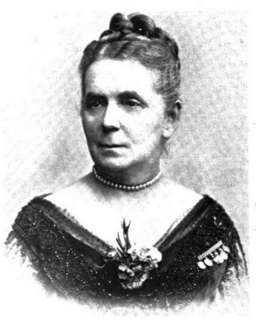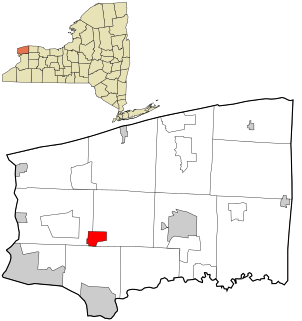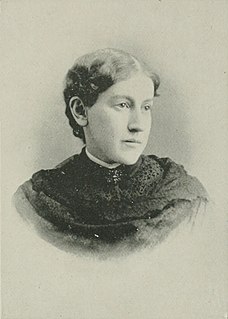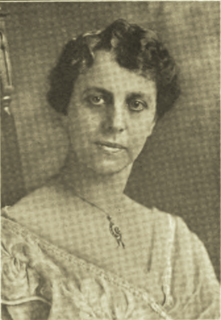
The "Little House" Books is a series of American children's novels written by Laura Ingalls Wilder, based on her childhood and adolescence in the American Midwest between 1870 and 1894. Eight of the novels were completed by Wilder, and published by Harper & Brothers. The appellation "Little House" books comes from the first and third novels in the series of eight published in her lifetime. The second novel was about her husband's childhood. The first draft of a ninth novel was published posthumously in 1971 and is commonly included in the series.

Charles Phillip Ingalls was the father of Laura Ingalls Wilder, known for her Little House series of books. He is depicted as the character "Pa" in the books and the television series.

Mathilde Marchesi was a German mezzo-soprano, a singing teacher, and a proponent of the bel canto vocal method.

Sanborn is a hamlet in the Towns of Cambria, Lewiston, and Wheatfield, in Niagara County, New York, United States, on the southern side of the intersection of New York State Route 429 and New York State Route 31. Originally called South Pekin after the formerly thriving hamlet of Pekin to the north, Sanborn was renamed in 1866 after Ebenezer Sanborn. The ZIP code for Sanborn is 14132.
Nelly and Nellie are female given names, also used as nicknames, which are derived from the names Helen, Ellen, Petronella, Danielle, Cornelia, Eleanor, Janelle, Chanelle, Penelope or Noelia.

Little Town on the Prairie is an autobiographical children's novel written by Laura Ingalls Wilder and published in 1941, the seventh of nine books in her Little House series. It is set in De Smet, South Dakota. It opens in the spring after the Long Winter, and ends as Laura becomes a schoolteacher so she can help her sister, Mary, stay at a school for the blind in Vinton, Iowa. It tells the story of 15-year-old Laura's first paid job outside of home and her last terms of schooling. At the end of the novel, she receives a teacher's certificate, and is employed to teach at the Brewster settlement, 12 miles (19 km) away.

Aglaja Orgeni, real name Anna Maria von Görger St. Jörgen, was a Hungarian operatic coloratura soprano.
James Ernest Perring was a British opera singer, voice trainer, and composer.

William Hall Sherwood was a late 19th and early 20th century American pianist and music educator who, after having studied in Europe with notable musicians, became one of the first renowned piano performers in the United States. He founded the Sherwood Music School, which was acquired by Columbia College Chicago in 2007.
Budd is an English surname. Notable people with the surname include:

Florence Trail was an American educator and author. Though she belonged to one of the wealthiest families of Maryland, she believed in the doctrine of self-support and left home to engage in teaching, first in Kentucky and North Carolina, and afterward in New York and Connecticut. On returning from an extended tour of Europe, she published My Journal in Foreign Lands. This was followed by other volumes, among them: Studies in Criticism, Under the Second Renaissance, and A History of Italian Literature. Trail died in 1944.

Nellie E. Brown Mitchell was an American concert singer and music educator, "one of Boston's favorite cantatrices."

Celeste M. A. Winslow was an American author. She was well known as a poet and contributor to the periodical literature of the day, as well as a political contributor to leading magazines and newspapers. Her work appeared in the Western Reserve Chronicle, The St. Joseph Herald, Ironton County Register, The Saint Paul Globe, Appleton Post, The Sumner County Press, Bolivar Bulletin, Chicago Tribune, and Independent-Observer.

Alice A. Andrews, later Alice A. Parker, was an American pianist, composer and musical director of the Andrews Family Opera. Later in life, she was a vocal coach and instructor in New York City.

Adelaide George Bennett was an American teacher, poet, and botanist. She is remembered for her poems which described Native American life and the Red Pipestone Quarry.

Agnes Moore Fryberger was an American music educator, lecturer, and author, as well as a clubwoman. She was a pioneer in the northwestern U.S. in lecture recitals on opera. Fryberger served as the Educational Director of the Minneapolis Symphony Orchestra (1924-25), and of the St. Louis Symphony Orchestra (1926-30). She was the first director of music appreciation at the University of Louisville. Her book, Listening Lessons in Music (1916), used in France, England, and the Philippines, was the first text that incorporated phonograph records into a school lesson's grading process.

Wilma Anderson Gilman was an American concert pianist, music teacher, and clubwoman. After making her debut in Brussels, she appeared in concerts in 34 U.S. states. Gilman was the first Minnesota musician asked to play as a soloist with the Minneapolis Symphony.

Windom College is a former American parochial school in Montevideo, Minnesota. It is the second school established in southwestern Minnesota by the Congregational church. It was founded in 1885 with the hope that its students would take more advanced courses in Carleton College. Originally named "Western Minnesota Seminary", it became the "Windom Institute" in 1891 in honor of Hon. William Windom, United States Senator and Secretary of the Treasury, who was a member of the Congregational church in Winona, Minnesota, the earliest of the Congregational churches in southeastern Minnesota. The name change in 1912 to "Windom College" gave western Minnesota its first college. Windom College ended operations in 1923. Its building was purchased by and became the official home of the Masons of Montevideo.

Stephen Albert Emery was a 19th-century American music composer and theorist. Many of the younger American composers were indebted to Emery for their instruction in the art of composition, and he stood in the front rank of American theorists. Emery has a national reputation as a lecturer upon musical subjects, a contributor to musical papers, a composer, a teacher of harmony, counterpoint and piano. As a composer, he wrote about a 150 published pieces, all of which were musicianly, and many of which enjoyed a large share of popular favor.

Allie Luse Dick was an American music teacher. She served as director of music at Hedding College, 1887-88, and at Missouri Wesleyan College, 1892-95. She identified with various religious, social, philanthropic and educational activities.

















